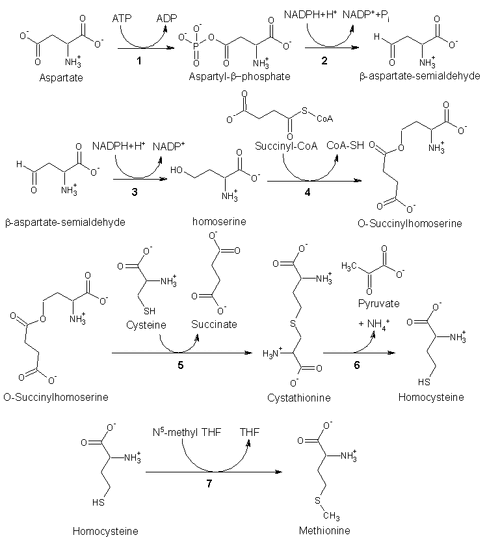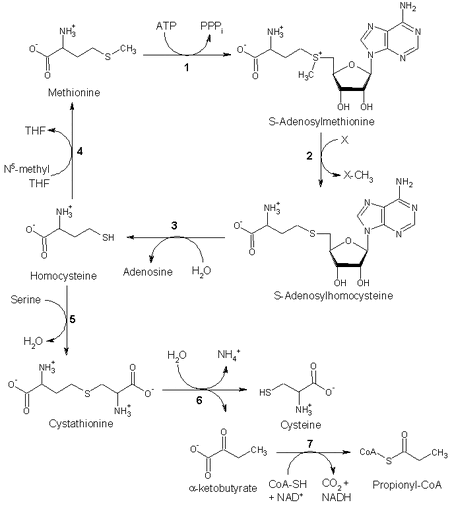Assessment |
Biopsychology |
Comparative |
Cognitive |
Developmental |
Language |
Individual differences |
Personality |
Philosophy |
Social |
Methods |
Statistics |
Clinical |
Educational |
Industrial |
Professional items |
World psychology |
Biological: Behavioural genetics · Evolutionary psychology · Neuroanatomy · Neurochemistry · Neuroendocrinology · Neuroscience · Psychoneuroimmunology · Physiological Psychology · Psychopharmacology (Index, Outline)
Template:Chembox Abbreviations
| style="background: #F8EABA; text-align: center;" colspan="2" | Methionine |
|---|---|
(S)-2-amino-4-(methylsulfanyl)-butanoic acid | |
| Identifiers | |
| CAS number | 63-68-3 |
| PubChem | 876 |
| SMILES | CSCC[C@H](N)C(O)=O |
| Properties | |
| Molecular formula | C5H11NO2S |
| Molar mass | 149.2 g mol-1 |
| Hazards | |
| style="background: #F8EABA; text-align: center;" colspan="2" | Except where noted otherwise, data are given for materials in their standard state (at 25 °C, 100 kPa) Infobox disclaimer and references |
Methionine (Template:Pron-en; abbreviated as Met or M)[1] is an α-amino acid with the chemical formula HO2CCH(NH2)CH2CH2SCH3. This essential amino acid is classified as nonpolar. Together with cysteine, methionine is one of two sulfur-containing proteinogenic amino acids. Its derivative S-adenosyl methionine (SAM) serves as a methyl donor. Methionine is an intermediate in the biosynthesis of cysteine, carnitine, taurine, lecithin, phosphatidylcholine, and other phospholipids. Improper conversion of methionine can lead to atherosclerosis.
Methionine is one of only two amino acids encoded by a single codon (AUG) in the standard genetic code (tryptophan, encoded by UGG, is the other). The codon AUG is also significant, in that it carries the "Start" message for a ribosome that signals the initiation of protein translation from mRNA. As a consequence, methionine is incorporated into the N-terminal position of all proteins in eukaryotes and archaea during translation, although it is usually removed by post-translational modification.
Biosynthesis[]
As an essential amino acid, methionine is not synthesized in humans, hence we must ingest methionine or methionine-containing proteins. In plants and microorganisms, methionine is synthesized via a pathway that uses both aspartic acid and cysteine. First, aspartic acid is converted via β-aspartyl-semialdehyde into homoserine, introducing the pair of contiguous methylene groups. Homoserine converts to O-succinyl homoserine, which then reacts with cysteine to produce cystathionine, which is cleaved to yield homocysteine. Subsequent methylation of the thiol group by folates affords methionine. Both cystathionine-γ-synthase and cystathionine-β-lyase require Pyridoxyl-5'-phosphate as a cofactor, whereas homocysteine methyltransferase requires Vitamin B12 as a cofactor.[2]
Enzymes involved in methionine biosynthesis:
- aspartokinase
- β-aspartate semialdehyde dehydrogenase
- homoserine dehydrogenase
- homoserine acyltransferase
- cystathionine-γ-synthase
- cystathionine-β-lyase
- methionine synthase (in mammals, this step is performed by homocysteine methyltransferase)
Other biochemical pathways[]
Although mammals cannot synthesize methionine, they can still utilize it in a variety of biochemical pathways:
Methionine is converted to S-adenosylmethionine (SAM) by (1) methionine adenosyltransferase. SAM serves as a methyl-donor in many (2) methyltransferase reactions and is converted to S-adenosylhomocysteine (SAH). (3) adenosylhomocysteinase converts SAH to homocysteine.
There are two fates of homocysteine:
- Methionine can be regenerated from homocysteine via (4) methionine synthase. It can also be remethylated using glycine betaine (NNN-trimethyl glycine) to methionine via the enzyme Betaine-homocysteine methyltransferase (E.C.2.1.1.5, BHMT). BHMT makes up to 1.5% of all the soluble protein of the liver, and recent evidence suggests that it may have a greater influence on methionine and homocysteine homeostasis than methionine synthase.
- Homocysteine can be converted to cysteine. (5) Cystathionine-β-synthase (a PLP-dependent enzyme) combines homocysteine and serine to produce cystathionine. Instead of degrading cystathionine via cystathionine-β-lyase, as in the biosynthetic pathway, cystathionine is broken down to cysteine and α-ketobutyrate via (6) cystathionine-γ-lyase. (7) α-ketoacid dehydrogenase converts α-ketobutyrate to propionyl-CoA, which is metabolized to succinyl-CoA in a three-step process (see propionyl-CoA for pathway).
Synthesis[]
Racemic methionine can be synthesized from diethyl sodium phthalimidomalonate by alkylation with chloroethylmethylsulfide (ClCH2CH2SCH3) followed by hydrolysis and decarboxylation.[3]
Dietary aspects[]
High levels of methionine can be found in sesame seeds, Brazil nuts, fish, meats, and some other plant seeds. [How to reference and link to summary or text] Most fruits and vegetables contain very little of it; however, some have significant amounts, such as spinach, potatoes, and boiled corn.[How to reference and link to summary or text] Most legumes, though high in protein, are also low in methionine. DL-methionine is sometimes added as an ingredient to pet foods.[4] Methionine, cysteine, and soy protein heated in a small amount of water creates a meat-like aroma.
See also[]
- Paradote - A Methionine-Paracetamol preparation that might prevent hepatotoxicity.
References[]
- British National Formulary 55, March 2008; ISBN 978 085369 776 3
- ↑ IUPAC-IUBMB Joint Commission on Biochemical Nomenclature. Nomenclature and Symbolism for Amino Acids and Peptides. Recommendations on Organic & Biochemical Nomenclature, Symbols & Terminology etc. URL accessed on 2007-05-17.
- ↑ Nelson, D. L.; Cox, M. M. "Lehninger, Principles of Biochemistry" 3rd Ed. Worth Publishing: New York, 2000. ISBN 1-57259-153-6.
- ↑ Template:OrgSynth
- ↑ What's in your dog's food?
External links[]
| Alanine | Arginine | Asparagine | Aspartic acid | Cysteine | Glutamic acid | Glutamine | Glycine | Histidine | Isoleucine | Leucine | Lysine | Methionine | Phenylalanine | Proline | Serine | Threonine | Tryptophan | Tyrosine | Valine |
| Essential amino acid | Protein | Peptide | Genetic code |
Template:Antidotes
| This page uses Creative Commons Licensed content from Wikipedia (view authors). |

